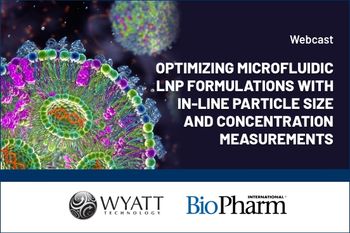Articles by Wyatt Technology

Thursday, November 17, 2022
Session 1: 8 am PST | 11 am EST | 5 pm CET
Session 2: 10 am CET | 9 am GMT | 6 pm JST
Session 3: 10am JST | 5 pm PST
Learn how to automate LNP production with in-line particle size and concentration measurements using multi-angle light scattering (MALS) and dynamic light scattering (DLS).

Tue, Aug 23, 2022 11:00 AM EDT
Advanced PAT tools such as RT–MALS offer in-depth characterization of biological molecules and nanoparticles to help optimize manufacturing processes.

Wyatt’s instruments and techniques constitute platform methods for effective product and process development, as well as quality control, of AAVs for gene therapy.

SEC-MALS identifies monomers, dimers, hexamers and higher aggregates of insulin to determine optimal formulation, storage and administration conditions.

Multi-angle light scattering, a powerful technology for biophysical characterization of biologics and LNPs, can also serve as an effective PAT tool to monitor product attributes during DSP.

SEC-MALS and CG-MALS characterize viral glycoprotein (vGP) self-association and the absolute stoichiometry and affinity of vGP:antibody interactions.

This white paper presents the characterization of protein-DNA complexes using two complementary multi-angle light scattering techniques, SEC-MALS and CG-MALS.

Light scattering quantifies key attributes of lipid nanoparticle gene vectors such as payload, size, titer, and stability in formulation and physiological media.

This note demonstrates the use of DLS and online multi-angle light scattering with field-flow fractionation (FFF-MALS) for characterizing retrovial viral vectors.

Dynamic and static light scattering are applied to show that the choice of heating rate significantly impacts thermostability measurements of an IgG.

SEC-MALS quantifies biophysical attributes of mRNA including molar mass, percent aggregates, Rg and Rh, and how they are affected by formulation and storage conditions.

Measurement of the diffusion interaction parameter versus temperature by dynamic and static light scattering provides comprehensive analysis of protein stability.


Screening studies of candidate proteins are critical in biopharmaceutical discovery. Preliminary assessment of the quality of the protein solutions by dynamic light scattering is imperative for reliable binding results.

By measuring fundamental biophysical attributes, light scattering aids in vaccine discovery, development, and manufacture. This paper covers light-scattering characterization of vaccine classes spanning a large range of physicochemical properties.









Assessing a drug candidate early in discovery and development minimizes the risk of costly downstream failure. This white paper illustrates the application of automated DLS for aggregation and stability investigations.

This paper includes a brief introduction to light scattering instruments and techniques, and how they are coupled with fractionation techniques. For several classes of vaccines – including subunit vaccines, mRNA-LNPs, polysaccharide conjugates, and plain old viruses – case studies demonstrate the utility and breadth of analyses using the light scattering toolkit. These include measuring size distributions, characterizing protein-protein binding, and quantifying glycan content in glycoproteins or nucleic acid cargo in nanocarriers. Multiple ways to detect aggregation and other measures of stability are also described.

***Live: Tuesday, December 15, 2020 at 11am EST| 8am PST| 4pm GMT| 5pm CET*** Nanopharmaceuticals: the latest in standardized methods for characterization and quantification ***On demand available after final airing until Dec. 15, 2021***

*** Three Events: Tuesday, Oct. 27, 2020 at 11am EDT| 8am PDT| 3pm GMT| 4pm CET Asia Pacific: Wednesday, Oct. 28, 2020 at 10:30 am IST| 1pm CST| 2pm JST Europe: Wednesday, Oct. 28, 2020 at 9am| 10am CET*** Characterizing complex nanoparticles, polymers and biotherapeutics is about to get a lot easier. ***On demand available after final airing until Oct. 28, 2021***

Learn about real-time light scattering, a novel technology for measuring quality attributes of bio- and nano-pharmaceuticals directly in the process stream.
Live: Wednesday, Feb. 26, 2020 at 11am EST | 8am PST | 4pm GMT | 5pm CET
On demand available after airing until Feb. 26, 2021
Register free






